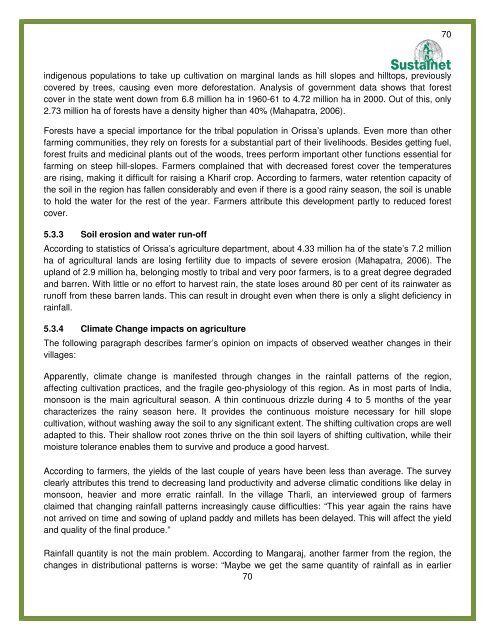Adaptation of small scale farmers to climatic risks in India - Sustainet
Adaptation of small scale farmers to climatic risks in India - Sustainet
Adaptation of small scale farmers to climatic risks in India - Sustainet
Create successful ePaper yourself
Turn your PDF publications into a flip-book with our unique Google optimized e-Paper software.
<strong>in</strong>digenous populations <strong>to</strong> take up cultivation on marg<strong>in</strong>al lands as hill slopes and hill<strong>to</strong>ps, previously<br />
covered by trees, caus<strong>in</strong>g even more deforestation. Analysis <strong>of</strong> government data shows that forest<br />
cover <strong>in</strong> the state went down from 6.8 million ha <strong>in</strong> 1960-61 <strong>to</strong> 4.72 million ha <strong>in</strong> 2000. Out <strong>of</strong> this, only<br />
2.73 million ha <strong>of</strong> forests have a density higher than 40% (Mahapatra, 2006).<br />
Forests have a special importance for the tribal population <strong>in</strong> Orissa’s uplands. Even more than other<br />
farm<strong>in</strong>g communities, they rely on forests for a substantial part <strong>of</strong> their livelihoods. Besides gett<strong>in</strong>g fuel,<br />
forest fruits and medic<strong>in</strong>al plants out <strong>of</strong> the woods, trees perform important other functions essential for<br />
farm<strong>in</strong>g on steep hill-slopes. Farmers compla<strong>in</strong>ed that with decreased forest cover the temperatures<br />
are ris<strong>in</strong>g, mak<strong>in</strong>g it difficult for rais<strong>in</strong>g a Kharif crop. Accord<strong>in</strong>g <strong>to</strong> <strong>farmers</strong>, water retention capacity <strong>of</strong><br />
the soil <strong>in</strong> the region has fallen considerably and even if there is a good ra<strong>in</strong>y season, the soil is unable<br />
<strong>to</strong> hold the water for the rest <strong>of</strong> the year. Farmers attribute this development partly <strong>to</strong> reduced forest<br />
cover.<br />
5.3.3 Soil erosion and water run-<strong>of</strong>f<br />
Accord<strong>in</strong>g <strong>to</strong> statistics <strong>of</strong> Orissa’s agriculture department, about 4.33 million ha <strong>of</strong> the state’s 7.2 million<br />
ha <strong>of</strong> agricultural lands are los<strong>in</strong>g fertility due <strong>to</strong> impacts <strong>of</strong> severe erosion (Mahapatra, 2006). The<br />
upland <strong>of</strong> 2.9 million ha, belong<strong>in</strong>g mostly <strong>to</strong> tribal and very poor <strong>farmers</strong>, is <strong>to</strong> a great degree degraded<br />
and barren. With little or no effort <strong>to</strong> harvest ra<strong>in</strong>, the state loses around 80 per cent <strong>of</strong> its ra<strong>in</strong>water as<br />
run<strong>of</strong>f from these barren lands. This can result <strong>in</strong> drought even when there is only a slight deficiency <strong>in</strong><br />
ra<strong>in</strong>fall.<br />
5.3.4 Climate Change impacts on agriculture<br />
The follow<strong>in</strong>g paragraph describes farmer’s op<strong>in</strong>ion on impacts <strong>of</strong> observed weather changes <strong>in</strong> their<br />
villages:<br />
Apparently, climate change is manifested through changes <strong>in</strong> the ra<strong>in</strong>fall patterns <strong>of</strong> the region,<br />
affect<strong>in</strong>g cultivation practices, and the fragile geo-physiology <strong>of</strong> this region. As <strong>in</strong> most parts <strong>of</strong> <strong>India</strong>,<br />
monsoon is the ma<strong>in</strong> agricultural season. A th<strong>in</strong> cont<strong>in</strong>uous drizzle dur<strong>in</strong>g 4 <strong>to</strong> 5 months <strong>of</strong> the year<br />
characterizes the ra<strong>in</strong>y season here. It provides the cont<strong>in</strong>uous moisture necessary for hill slope<br />
cultivation, without wash<strong>in</strong>g away the soil <strong>to</strong> any significant extent. The shift<strong>in</strong>g cultivation crops are well<br />
adapted <strong>to</strong> this. Their shallow root zones thrive on the th<strong>in</strong> soil layers <strong>of</strong> shift<strong>in</strong>g cultivation, while their<br />
moisture <strong>to</strong>lerance enables them <strong>to</strong> survive and produce a good harvest.<br />
Accord<strong>in</strong>g <strong>to</strong> <strong>farmers</strong>, the yields <strong>of</strong> the last couple <strong>of</strong> years have been less than average. The survey<br />
clearly attributes this trend <strong>to</strong> decreas<strong>in</strong>g land productivity and adverse <strong>climatic</strong> conditions like delay <strong>in</strong><br />
monsoon, heavier and more erratic ra<strong>in</strong>fall. In the village Tharli, an <strong>in</strong>terviewed group <strong>of</strong> <strong>farmers</strong><br />
claimed that chang<strong>in</strong>g ra<strong>in</strong>fall patterns <strong>in</strong>creas<strong>in</strong>gly cause difficulties: “This year aga<strong>in</strong> the ra<strong>in</strong>s have<br />
not arrived on time and sow<strong>in</strong>g <strong>of</strong> upland paddy and millets has been delayed. This will affect the yield<br />
and quality <strong>of</strong> the f<strong>in</strong>al produce.”<br />
Ra<strong>in</strong>fall quantity is not the ma<strong>in</strong> problem. Accord<strong>in</strong>g <strong>to</strong> Mangaraj, another farmer from the region, the<br />
changes <strong>in</strong> distributional patterns is worse: “Maybe we get the same quantity <strong>of</strong> ra<strong>in</strong>fall as <strong>in</strong> earlier<br />
70<br />
70




